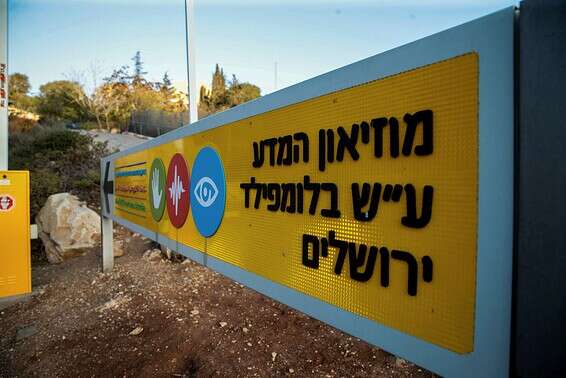Satellite stabilization with magnets and the effect of flame retardants washed into the sea: This year's competition was attended by 61 young scientists from around the country, who presented 53 outstanding projects • Full list of winners
Young Scientists Competition 2019 // Photo: Yuval Cohen Aharonov
Last night (Tuesday), the winners of the "Young Scientists and Developers Competition in Israel 2021" were announced.
Due to the Corona crisis, the event took place this year virtually in Zoom Rooms, as did the winners' announcement ceremony that was broadcast live on the Facebook page of the Jerusalem Science Museum.
"Especially these days, it was important for us to hold the competition, even if it meant holding it online, and encouraging the next generation of scientists and developers in Israel who may have the solution to the next crisis," said Maya Halevi, director of the Science Museum. "Online competition We will be able to return to the 'old format' next year and host all the students who will reach the final stage at our museum, and present their wonderful works to the general public."
Prizes were awarded for first, second and third place as well as commendation marks for outstanding and unique works.
The winners will participate and represent Israel in two international competitions that have been held for decades, in which they will meet hundreds of students from all over the world and compete with their works in various fields.
Winners of these competitions are awarded cash prizes and the opportunity to be hosted at research institutes in Europe.
The competition's jury is headed by the physicist, Prof. Hanoch Gutfreund, former president of the Hebrew University, and alongside him are senior judges from academia and industry in the country.
The young scientists and developers are accompanied throughout the screenings, preparations and during the days of the competition are supervisors, doctoral students and development engineers of high-tech companies under the guidance of Prof. Gadi Glazer from the Hebrew University and the Science Museum staff.
The ceremony was attended by Education Minister Yoav Galant, Chairman of the Executive Committee of the Bloomfield Museum of Science Jerusalem Jerusalem Shlomo Yanai, German Ambassador to Israel Dr. Susanna Vazum-Reiner, EU Research and Innovation Head in Israel Andre Carignani Di Novoli, Vice President The Israeli School of Science Prof. David Harel, Goren-Monti-Ferrari Representative Michaela Goren-Monti and Senior Director of National Programs and Head of Science and Technology, Mohana Fares.
in the first place
Inbar Kedem is a student at the Nofei HaBesor School, Magen and the Meitar program, for his work in identifying and quantifying the saturation of Macrobrachium rosenbergii cancers in growth vessels, according to image analysis using artificial intelligence.
Sapir Shalom is a student of the Israeli High School of Sciences and Arts in Jerusalem, for her work in developing a method for the simultaneous flooring of a founding panel of mutations that cause hereditary retinal diseases in the Israeli population.
Second place
Tamar Mashorer, a high school student at the Jerusalem University and the "Alpha" Jerusalem program, for her work in describing neural activity in the auditory cortex following the learning of vocal categories.
Shira Klein, a student at Ulpanat Tzvia, Ma'ale Adumim and the "Alpha" program Ariel, for her work in stabilizing a young satellite using magnets.
Noa Gonen, a student at the Leo Buck Education Center, Haifa, for her work under the influence of flame retardants that are washed into the sea when extinguishing fires on microorganisms in the marine environment.
Ariel Priel, a student at the Bnei Akiva Yeshiva, Givat Shmuel and the "Alpha" Weizmann program, for his work in searching for his asteroid twins in the asteroid belt.
Third place
Omar Eyal, a high school student at the University of Jerusalem and the "Alpha" program in Jerusalem, for his work on the first Nickel Erogel Catalyst on the way to green transportation.
Naomi Snir, a student from Galili High School, Kfar Saba and the "Idea" program in Tel Aviv, for her work in representing women in Chartres Cathedral, France, and their connection to female patronage and the worship of the Virgin.
Yahel Manor, a student at the Leo-Bak Education Center, Haifa and the "Alpha" Technion program, for her work in finding computerized hypotheses for combined fractions.
Adam Jaber, a high school student at the University of Jerusalem and the Jerusalem Alpha program, for his work on the distribution coefficients of the trace elements in the eclogite and peridotite systems in the upper mantle.
A special award named after Noam Knafo was awarded to Liraz Dai, a comprehensive urban high school student named Begin, Eilat, for her work in capturing prey in freshwater fish: differences in kinematics and pumping forces.
A special award from the Society for Science was given to Nathaniel Teller, a high school student named after Yitzhak Shamir, Petah Tikva. For his project in which he created a game system for improving fine motor skills and eye coordination.
The Bloomfield Museum of Science, Jerusalem, devotes a significant part of its activities to international projects, to teaching science and technology education among young people, promoting scientific excellence and raising awareness of employment in these fields. The population has been holding the competition for scientists and young developers in Israel for the past 24 years, with the participation of dozens of teenagers aged 15-21 from all over the country.
The competition, part of the EU's research and development programs to encourage and collaborate between young scientists in Europe and Israel, has produced over 1,000 graduates over the years, most of whom successfully integrate into research and academia, industry, business in Israel and around the world.

